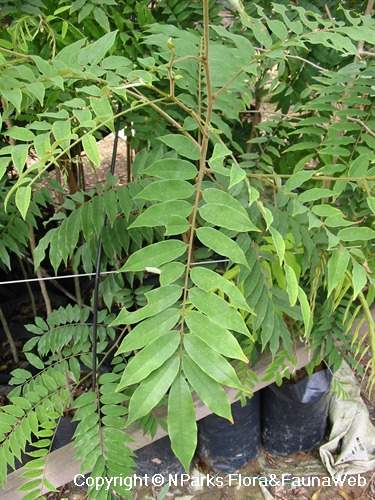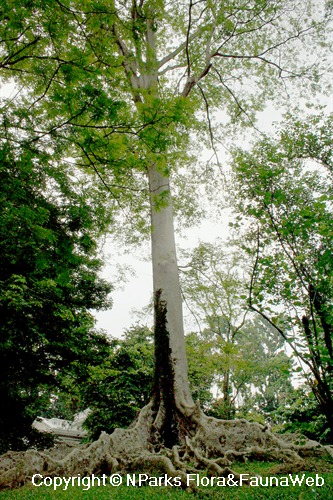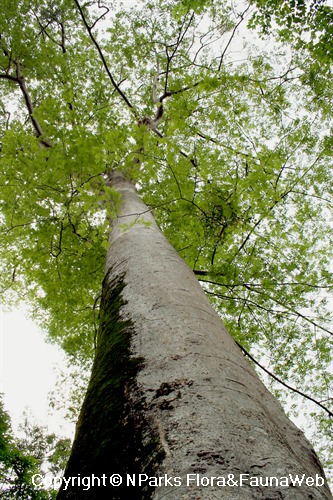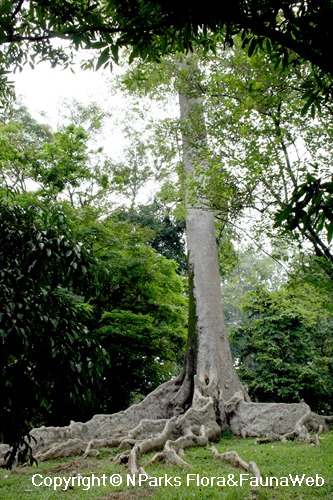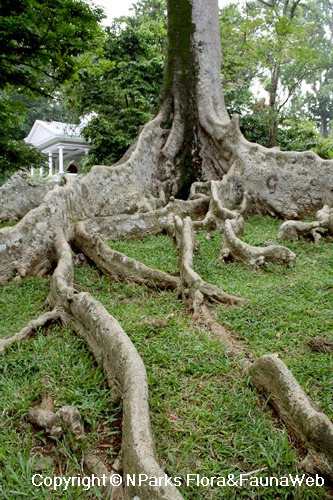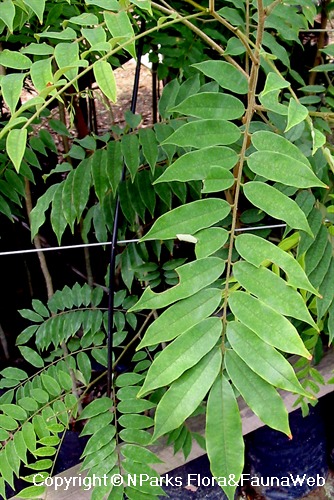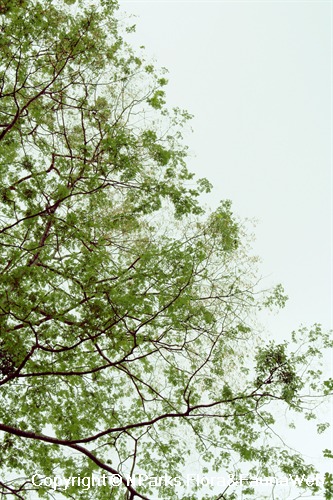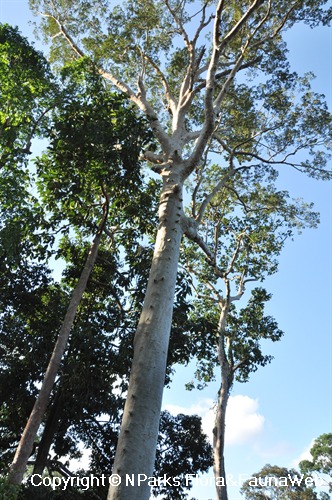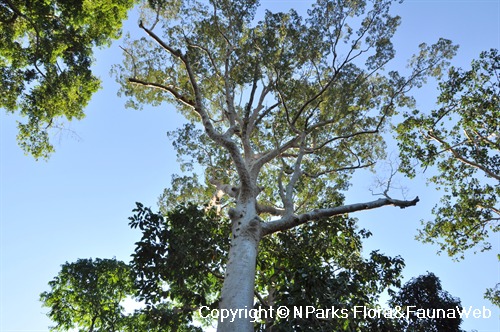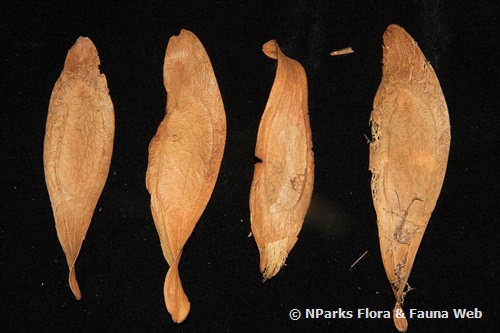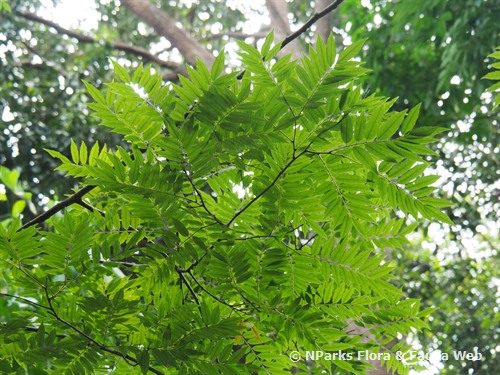
Back
Koompassia excelsa (Becc.) Taub.
| Family Name: | Fabaceae (Leguminosae) |
| Synonyms: | Koompassia parvifolia |
| Common Name: | Honey Bee Tree, Tualang, Sialang, Menggaris, Kayu Raja, Tapang, Tualang Bee Tree |
Name
Classifications and Characteristics
| Plant Division | Angiosperms (Flowering Seed Plants) (Dicotyledon) |
|---|---|
| Plant Growth Form | Tree (Big (>30m)) |
| Lifespan (in Singapore) | Perennial |
| Mode of Nutrition | Autotrophic |
| Plant Shape | Irregular |
| Maximum Height | 45 m to 80 m |
| Tree or Palm – Trunk Diameter | 2 m |
Biogeography
| Native Distribution | Thailand, Philippines, Malaysia, Indonesia |
|---|---|
| Native Habitat | Terrestrial (Primary Rainforest) |
| Preferred Climate Zone | Tropical |
Description and Ethnobotany
| Growth Form | Leguminous emergent forest tree, one of the tallest tropical tree species, measuring up to 80-90m height. |
|---|---|
| Crown | Dome-like or mushroom-like, with delicate bright to pale green foliage and gnarled branching. |
| Trunk | Huge (up to 2m across), columnar, with smooth greyish bark, branching at only around 30m from ground, supported by large root buttresses at base. |
| Foliage | Leaves light green, pinnately-compound with small alternate leaflets and terminal leaflet. Species is drought-deciduous once yearly, between Feburary and June, during which crown becomes bare for a few weeks. |
| Flowers | Very small, 5 petals, clustered in terminal panicles. Produced at 5-6 year intervals, after formation of new leaves subsequent to shedding of old ones. Blooming observed to coincide with Dipterocarp species in forest. |
| Fruit | Thin flat papery pods, twisted near base, with broad wing around margin, ripening to brown, non-dehiscent, containing 1 flat seed. |
| Habitat | Lowland primary rainforest, mainly at moist locations along rivers, in valleys and lower slopes of hills, restricted to north of Selangor and Pahang (Kuala Lumpur-Kuantan latitude) on Peninsular Malaysia. |
| Associated Fauna | Tree's trunk said to be too slippery for Helarctos malayanus (Malayan Sun Bear) to climb, hence species is preferred host for Apis dorsata (Asian Giant Honey Bee) to build their massive honeycombs. Leaves eaten by Trachypithecus obscurus (Dusky Leaf Monkey) during dry season. |
| Cultivation | Prefrers moist but well-drained soils. Sap may cause skin irritation and rash in certain individuals. Protect from lightning strikes and open fires, as species is highly-flammable (especially when alive). Propagate by seeds or stem cuttings. |
| Etymology | Genus epithet Koompassia derived from Kempas, local vernacular name for members of this genus. Species epithet excelsa means 'tall', a reference to the tree's mature height. Malay name Tualang means 'tree of swarming bees'. |
| Ethnobotanical Uses | Others: Aviculture: Host tree for Apis dorsata (Giant Asian Honey Bee), which hangs its large parabolic combs from the tree's horizontal branches, and whose honey are harvested by the local people. Timber: Not a traditional commercial hardwood, as high-silica timber is not only very hard and difficult to cut, but also brittle and splinters easily when sawn. Also indirectly protected from logging by its association with honey, which is worth more than the timber itself. But due to decline of other hardwood timber species, the trees have been harvested more frequently in recent times for its timber, which is sold as Mangaris wood, and can be used for tool handles, railway sleepers and flooring. Buttress wood said to be good for dining tables. Culture: Harvests of wild honey associated with various local myths and religious rituals. Malays and Orang Asli also believe that the trees are haunted. |
Landscaping Features
| Landscape Uses | General |
|---|---|
| Thematic Landscaping | Naturalistic Garden |
| Plant & Rootzone Preference or Tolerance Remarks | Clay soils |
Fauna, Pollination and Dispersal
| Seed or Spore Dispersal | Abiotic |
|---|
Plant Care and Propagation
| Light Preference | Full Sun |
|---|---|
| Water Preference | Moderate Water |
| Plant Growth Rate | Moderate |
| Rootzone Tolerance | Fertile Loamy Soils, Well-Drained Soils, Poor Infertile Soils, Acidic (low pH) Soils |
| Maintenance Requirements | Moderate |
| Propagation Method | Seed, Stem Cutting, Air-Layering |
Foliar
| Foliage Retention | Drought / Semi-Deciduous |
|---|---|
| Mature Foliage Colour(s) | Green |
| Mature Foliage Texture(s) | Smooth |
| Foliar Type | Compound (Even-Pinnate) |
| Foliar Arrangement Along Stem | Alternate |
| Foliar Shape(s) | Non-Palm Foliage (Oblong) |
| Foliar Venation | Pinnate / Net |
| Foliar Margin | Entire |
| Foliar Apex - Tip | Cuspidate |
| Foliar Base | Rounded / Obtuse |
| Typical Foliar Area | Microphyll ( 2.25cm2 - 20.25 cm2 ) |
| Leaf Area Index (LAI) for Green Plot Ratio | 3.0 (Tree - Intermediate Canopy) |
Non - Foliar and Storage
| Trunk Type (Non Palm) | Woody |
|---|---|
| Bark Colour(s) | Grey |
| Stem Type & Modification | Woody |
| Root Type | Underground (Tap Root, Fibrous Root) |
Floral (Angiosperm)
| Flower & Plant Sexuality | Bisexual Flowers |
| Inflorescence Type | Panicle |
|---|---|
| Flowering Habit | Polycarpic |
| Flowering Period Remarks | At intervals of 5-6 years |
Fruit, Seed and Spore
| Mature Fruit Colour(s) | Brown |
|---|---|
| Fruit Classification | Simple Fruit |
| Fruit Type | Indehiscent Dry Fruit , Samara |
Image Repository
Others
| Master ID | 1690 |
|---|---|
| Species ID | 2983 |
| Flora Disclaimer | The information in this website has been compiled from reliable sources, such as reference works on medicinal plants. It is not a substitute for medical advice or treatment and NParks does not purport to provide any medical advice. Readers should always consult his/her physician before using or consuming a plant for medicinal purposes. |

